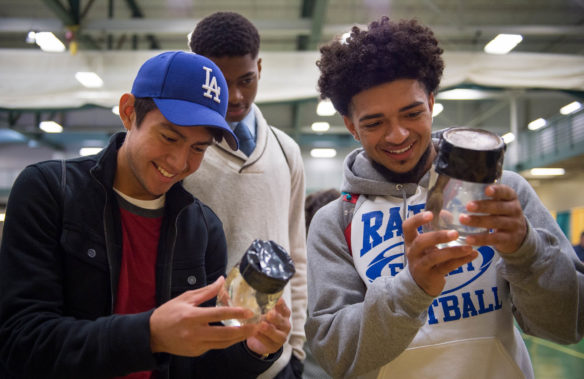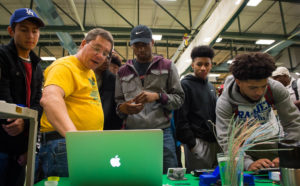
Young Male Leadership Academy participants Ben Meza, left, a freshman at Bowling Green High School, and Codey Stoll, a senior at Warren East High School (Warren County), look at preserved fish at the aquaculture department’s table during an open house at Kentucky State University. The leadership academy encourages young men of color to become special education teachers.
Photo by Bobby Ellis, Oct. 29, 2016
By Brenna R. Kelly
Brenna.kelly@education.ky.gov
When many Kentucky teachers look out across their classrooms, they see a diverse group of students. But when they look around the staff meeting, chances are the faces they are seeing are predominantly white and female.
Studies have shown that all students benefit from being taught by a diverse mix of teachers. Learning from teachers who are different from themselves can help students dispel negative stereotypes and prepare them to live and work in an increasingly diverse society.
Minority students, studies show, benefit from having role models who look like themselves and have an understanding of their culture. Minority teachers also have been found to have higher expectations of minority students.
“Our student population is changing across the country and the state,” said Renee Scott, the Kentucky Department of Education’s liaison for the Teacher Recruitment and Retention for Educator Excellence initiative (Project TRREE). “Our population of minorities – especially African-Americans and Hispanics – continues to grow, but in our schools we don’t see that diversity in terms of our teacher population.”
Just 4.6 percent of the more than 40,000 teachers in the state are minorities, meanwhile, 21.7 percent of Kentucky students are minorities.
But it’s not only a lack of diversity in race and ethnicity, most Kentucky teachers are women. Men make up just 22 percent of the teaching corps.
“We want, as much as possible, to have our teaching population mirror our student population,” said Denise Hardesty, coordinator of Western Kentucky University’s Minority Teacher Recruitment Center.
And with the minority student population increasing at a faster rate than the minority teacher population, “that gap is going to get bigger and bigger unless we make some changes,” she said.
School districts, the Kentucky Department of Education and the state’s higher education institutions are working to do just that.
Young Male Leadership Academy
In western Kentucky, the Young Male Leadership Academy, is designed to get young men from diverse background interested in becoming not only teachers, but special education teachers. The program – a partnership between Warren County Schools and Bowling Green Independent, KDE and Western Kentucky University (WKU) – is part of Project TRREE, an initiative to increase the number of highly qualified special education teachers who come from linguistically, culturally and ethnically diverse backgrounds.
Students join the program in 7th through 9th grades, then attend Saturday academic enrichment activities, a week-long leadership academy and receive help in applying for college scholarships.

Jens Hannemann, a technology professor at Kentucky State University, speaks to students from the Young Male Leadership Academy during an open house at KSU. Photo by Bobby Ellis, Oct. 29, 2016
There are 18 students in the program this year, said Michael Coleman, a minority teacher recruiter at Warren County Public Schools and co-coordinator of the academy. When he recruits students for the program, Coleman finds many aren’t eager to become teachers. Often, young men of color haven’t seen a teacher who looks like them, he said
Students don’t have to declare they want to be a teacher to join the academy, but they have to write an essay about why they want to participate and plan to attend college, Coleman said.
“We want them to develop leadership and communications skills, because if you are going to be a teacher, you’re going to have to know how to communicate,” he said.
The students are encouraged to take dual credit and Advanced Placement classes to help them become college-ready.
“We want to develop a relationship with them and we want to follow them through their high school career,” he said. “The more we develop them, maybe we can convince them and get the idea in their minds to become a teacher.”
During the Saturday sessions, the students visit colleges, learn leadership skills, work on their resumes and college applications, and get help applying for the Minority Educator Recruitment and Retention (MERR) Scholarship, which can provide up to $5,000 a year for minority students majoring in education at Kentucky public universities. The week-long summer session includes many of the same topics and last year culminated with a trip to Boston.
At both the Saturday and summer sessions, male and minority educators talk to the students about their careers.
“When young males see that there are teachers and administrators like them, it will make them realize ‘maybe I do want to become a teacher,’” Coleman said.
Though the program began in 2007, it was revised three years ago to allow students to continue until they graduate high school, Hardesty said. The first students to complete the program under the revised model will graduate this spring.
“We really think we’ll have a 100 percent college-going rate of that group,” Hardesty said. “I would be pretty excited if we get 30 percent of them to go into teaching.”
Of those seven seniors, three or four are planning to attend WKU.
“Of course my goal is get all of them to come to WKU, but my ultimate goal is for them to go to college somewhere in the state of Kentucky and major in education,” she said.
Chances are if those students become teachers, they will end up teaching in Warren County or Bowling Green Independent. According to a Stanford University study, more than 60 percent of teachers in the country end up teaching within 20 miles of where they went to school.
“This is really a grow-your-own program,” Coleman said. “We want to use this program to keep young men in Warren County and to become teachers in Warren County.”
Educators Rising in Jefferson County schools
In Louisville, Jefferson County Schools is also trying to develop its own teachers. The district uses Educators Rising, a program designed to cultivate highly skilled educators and guide students through the system.
“The students that are in the classroom right now are going to be the teachers five, six, seven years from now,” said Sylena Fishback, who was Jefferson County’s minority teacher recruiter for four years.
That’s why it’s important for Jefferson County – with 36 percent African-American students and 13.7 percent African-American teachers – to cultivate teachers.
Any school can start an Educators Rising chapter for free on its website, she said. Students in the extracurricular program attend college tours to visit education professors, attend workshops on the education program entrance exam, and attend district and national conferences.
Minority students in the group also get help applying for the MERR scholarship, said Fishback, who is now a specialist at the district’s Volunteer Talent Center.
Students in three Jefferson County high schools – Fairdale, Seneca and Atherton – also can follow an education pathway that includes four education dual credit classes. Seniors in any of the district’s high school can apply for a paid internship co-teaching in a middle or elementary school, she said.
Both of the programs not only benefit the state by trying to produce a highly qualified, diverse teacher population, but they also benefit students who might not otherwise pursue a college education, Scott said.
“We always talk about this opportunity gap and providing the opportunity for students to see beyond their own environments,” she said. “For many of these students, they will be the first in their families to go to college and become a teacher.”
MORE INFO …
Michael Coleman Michael.Coleman@Warren.kyschools.us
Renee Scott Renee.Scott@education.ky.gov
Denise Hardesty Denise.Hardesty@wku.edu
Sylena Fishback Sylena.Fishback@Jefferson.kyschools.us



Leave A Comment